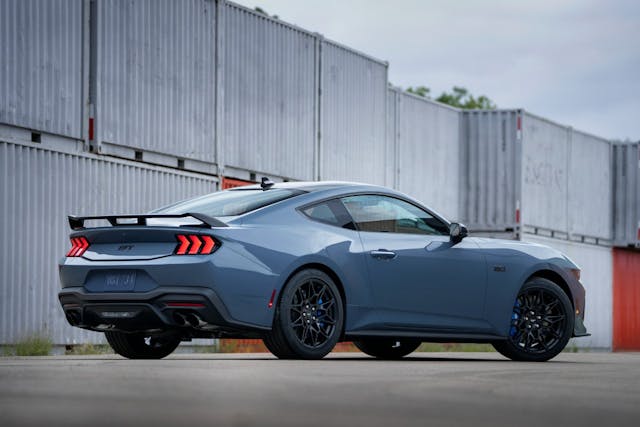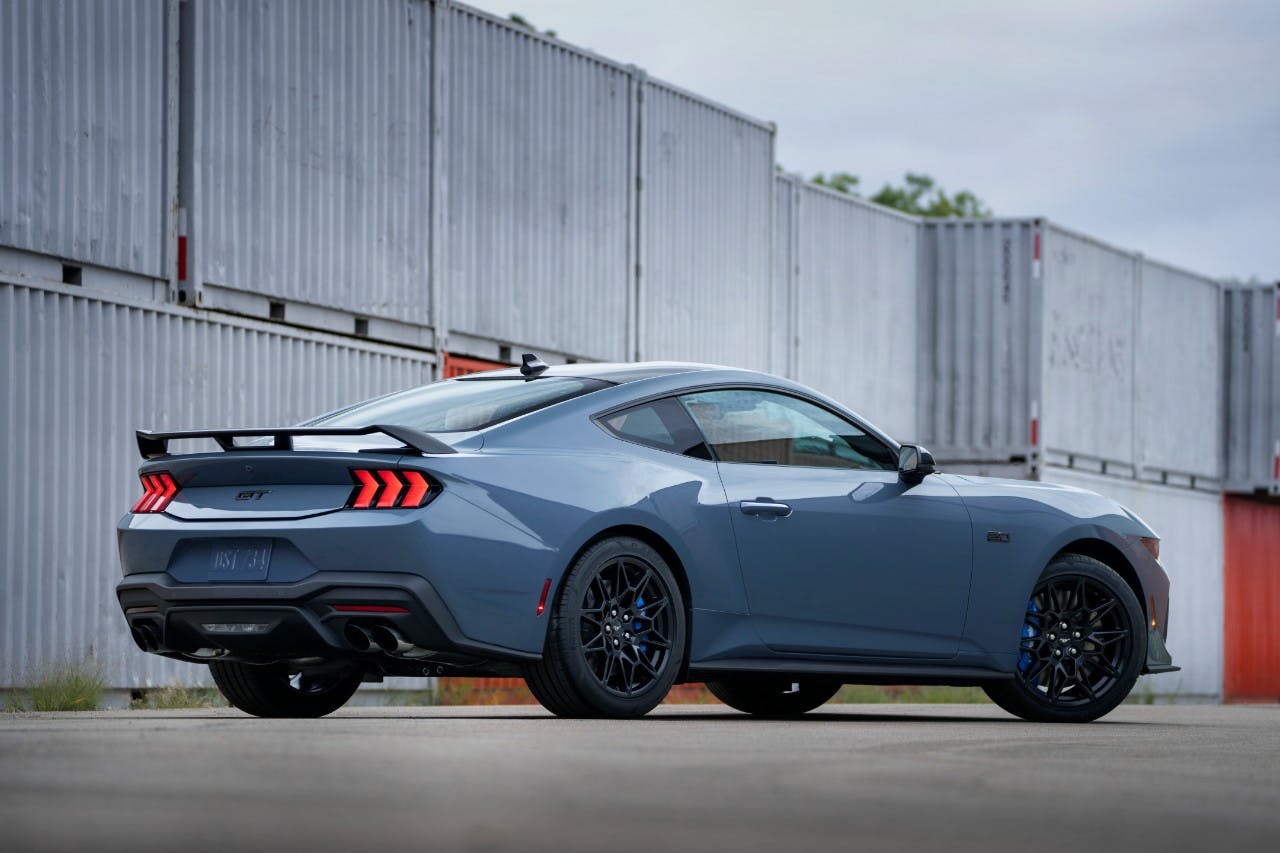Media | Articles
Opinion: New Mustang is next verse, worse than the first
After much ado, the seventh-generation, 2024 Ford Mustang cometh. In the end, the rumors of hybridization, all-wheel drive, and the Explorer’s RWD/AWD platform were premature. The new Mustang, codename S650, remains pretty much business as usual. What it amounts to is more or less a mild, unremarkable evolution of the existing rear-drive architecture. But what does that mean for America’s pony car, and what might end up being this storied nameplate’s internal-combustion swan-song?
Ford is going all in on electrification as it reaps success from sticking batteries into the F-150 and leveraging the Mustang name to sell an electric crossover. For the moment, it appears to be happy to let the traditional Mustang wither on the vine … at least in the big-picture sense. Lest we forget, the Mustang is now the only non-pickup, non-crossover Ford you can buy in the United States. Maybe Ford realized its competition, the Chevrolet Camaro and Dodge Challenger, are not much longer for this world and it wouldn’t take much to keep the Mustang on top in the muscle car game.

The bare minimum appears to have been just enough. There were rumors that Ford would bolt its new Mustang onto the Explorer platform (CD6), which would have allowed for more up-to-date powertrains, including a hybrid setup. Historically, it should be mentioned, both the Mustang and the Camaro have kept up with prevailing technological and aesthetic trends. Both nameplates, for example, added a turbocharged four-cylinder model as a base engine in their most recent generations, but the Challenger and the Mustang in particular have been stressing a more retro vibe since the mid-2000s. Now it appears to be running over the same old ground, albeit in a new wrapper.
Part of the long-term success of the Mustang, even through its lean years, was how it has adapted to the market of its moment. It started in the Sixties when the Mustang was born as a way to give the common man flash for not much cash. Soon, Ford proved its mettle with growly Shelbys and considerable motorsports success. The hangover from the Sixties was the crisis-ridden Seventies, but the Mustang endured the Malaise Era and stayed alive through some questionable baroque styling and not much performance. Still, it was a reinvention that was correct for where the market was at the time.
When the Eighties arrived, the Mustang found itself with a hatchback and more considered Euro-style appearance, but again the pony car held true to making the best of its humdrum undercarriage with up-to-the-minute looks and features. (The Camaro marched in lockstep and did the same.)
Marketplace
Buy and sell classics with confidence
Now for the full disclosure: Remember my old ’71 Duster, which I’ve mentioned in previous articles? When I realized that keeping such a highly strung beast on the road was out of my depth, I traded it for a Fox-body. Its motor was a boat-anchor 3.3 and it had a weird manual shift layout with an overdrive. I wired in my Sony CD changer wrongly, which left me to choose between headlights or music—not both at the same time. (This led to a rather interesting night out at the cinema with a girl I’d promised to take out in my Mustang.) But it was a Mustang nonetheless, and I’ve always lusted after one of the last ’93 Cobras after reading about them in a road test with its competitors.
Ford dipped it toes into the retro pool with the SN95 generation in 1994, before awkwardly forcing straight lines onto the 1999 redesign. But when S197 appeared in 2005, chief designer J Mays—who made his name with retrofuturism—set the controls straight for 1964. His work on this design was not influenced (as many believed) by the Mustang Giugiaro concept which would not appear until 2006. I’ve mentioned before how I think the 2005 Mustang is a bit blocky and ungainly, needing a bit more finesse to really sail as a successful throwback in the same way as the Challenger does.

So that’s where we’ve been ever since, Ford like Dodge and Chevrolet deciding that the first versions of these pony cars are the definitive ones. Translation: this is what these cars are and this is how you will remember them. No new Fox-body or pop-up headlight Camaros, no reinvention to keep up with the times; we’re selling you nostalgia rather than a contemporary update of the muscle car formula. Can you imagine a manufacturer green-lighting something as bold as the F-body glass tailgate today? The accountants would be in fits. The Charger has shamelessly kept up its rubber-burning reputation, but as we’ve seen with the new Daytona SRT concept, at least Dodge are trying something new.
S650 is, deep down, a remix of a remix of the 1964 original. It leans heavily on the outgoing S550 Mustang, using essentially the same underpinnings. It’s got a slightly more chiseled appearance, but the reality is one of a very big facelift.
Tooling up for a car is expensive, and among the biggest investments—apart from the lights—is the body in white. It’s the fundamental structure, the actual skeleton on which the car is built. Looking at this new Mustang, you can see the bones are carry-over. Doing it this way allows Ford to update the sheet metal, but I’d argue they’ve merely made it worse. It’s all a bit more of an exaggeration on the existing theme, with bigger hips and a more aggressive down-the-road graphic up front.

The front light to fender is a critical visual relationship, and this is one of those areas where we’re talking about fractions of an inch. Ford lowered the headlights for 2023 and made them a bit messy by trying to replicate the three vertical tail lamps, and by continuing a straight line across the grille managed to give the car a frowning look. The previous Mustang avoided this because its grille shape was more pronounced, so you didn’t notice as much. The S650 feels like a rearranging of existing graphical elements to no great effect.
The Mustang has dropped the black infill panel between the tail lights, reducing some of the visual break-up at the back. Having something to lessen the visual impact of painted sheet metal is important, because too much can bodywork can look bland. Of course, fewer parts means less cost.

It seems strange that car that trades primarily on its driving experience and tactile fulfillment settles for large touchscreens in its interior, especially after the previous model made such a big deal of having a “cockpit” inspired by aircraft design. We’ve seen good and bad TFT implementations over the last few years, but this feels terribly misguided. Ergonomics aside, the whole thing appears incongruous and not really in keeping with the muscle car aesthetic. Mostly the same, but worse, is not what I’d call a recipe for long-term success. Like the Camaro, the Mustang is no longer evolving to keep up with the times but remixing an existing concept to ever decreasing returns.
Now, I can hear you all saying that I’m contradicting myself, and after all, didn’t I praise the Challenger for doing exactly that? Here’s the difference. The Challenger had one look, stuck to it, and was always a unique ownership proposition. It never chased trends. The Mustang, for better or worse, did. It remained current and was even adaptable enough to be a huge hit in Europe, so its failure to do so this time around disappoints me.
I’m glad I didn’t stay up to watch the reveal like I may have done in the past. Because other than that ’93 Cobra, what I really want is a ’71 Mach 1 on dog-dish steelies.
***
Adrian Clarke is a professional car designer, earning a degree in automotive design from Coventry University and a Masters in Vehicle Design from the Royal College of Art in London. He worked for several years at a major European OEM, and in the ’90s his daily driver in London was a 1979 Ford Thunderbird.










Ford has already “given up” on cars, so the fact that they have one left for the U.S. market should tell you all you need to know about this abomination. And you can take that giant touch screen and stuff it
Unremarkable? The Camaro is going the way of the Dodo and the ICE Challenger is dead as well. I’d say very remarkable.
The fact that theICE Mustange gets even one more iteration is due to the value of the name alone. There’s not enough volume to justify any type of redo past what we’re getting. Be happy were even getting this.
Retro pool 1995?
SN95 was like 2023, it was following trends as becoming a sports car but reusing the parts bin (fox4), and not retro. It sort of worked for Ford til 97, but the lackluster 3.2/4.6L offerings really ended up being a hit with rental fleets: a death sign to any car icon.
It was the new edge that Ford was forced to back a retro themed design theme…. which puts us to today.
Would someone please fire this ‘writer’?
Yeah. Anyone who doesn’t like the current Mustangs but yearns for a ’71, the ugliest, fattest, clunkiest of the first generation of Mustangs does not have the ability to judge styling at any level.
I’m wanting that 2024 beast, will be the 3rd , ’66’ ’08’ bad ass cars,loved them both
Ford Engineers: Let’s take the S550, make it ugly on the outside, boring on the inside, fill it with screens to make it unappealing to anyone who cares about asthetics, and take away the manual from the EcoBoost to punish lower budget buyers…even though the take rate was only 10%, you should have kept it out of principle. Honestly, for that last bit alone is going to make me buy a Camaro instead.
bottom line everybody..what made the mustang a winner..from the first year they were good looking simple in design and equipment… but most important of all! ANYONE ! could afford one ..from high school grads..and university students.. to grand mothers the automakers,,have forgotten what made Henry Ford,,who he was
Better than the rest!
When your best ideas are 50 or more years old, it’s time to copy Tesla. Oh wait, that’s already happening. Let’s see some truly original ideas please.